With 13 forest campgrounds, two state parks and the ability to backpack a tent deep into the wilderness, Ocala National Forest camping opens up a world considerably disparate from Florida’s coastal crush.
You can swim in the cool, clear waters of the forest’s many springs, paddle uniquely scenic spring runs, lakes and rivers, and explore the forest on hundreds of miles of forest roads and wilderness trails.
Welcome to the heart of Florida.
4 Ocala National Forest Recreation Areas
Popular hubs with developed campgrounds
Developed campgrounds in the forest’s Recreation Areas have more amenities, although only one has full hookups for RVs. They also feature better security with gated campgrounds and on-site campground hosts.
The recreation areas have day-use areas offering swimming, kayaking, direct access to trails for hiking, off-road bicycles and even trails for horseback riding.
They are also more likely to have cell-phone service because of their location near highways that cut through and around the forest (but don’t expect much beyond one or two bars).
Salt Springs Recreation Area

Salt Springs has the largest, most developed campground in Ocala National Forest — and it’s the only campground in the forest with full hookups for recreational vehicles.
It’s also the most difficult forest campground to secure a reservation when you want it.
The recreation area features a major spring with a large swimming area around the springhead, spilling into a broad, five-mile spring run leading to Lake George and the St. Johns River.
A large swimming area at the spring head is popular year around because of its refreshing and constant 74-degree temperature emerging from underground rivers at the rate of 52 million gallons a day.
The spring run is accessible from the boat ramp at the Salt Springs Marina. which rents paddle boards, kayaks, canoes, skiffs, and pontoon boats. The flow of water to Lake George is slow enough for paddling out and back.
There is another unimproved boat launch in the campground.
Campers and day-use visitors have access to hiking trails and off-road bicycling.
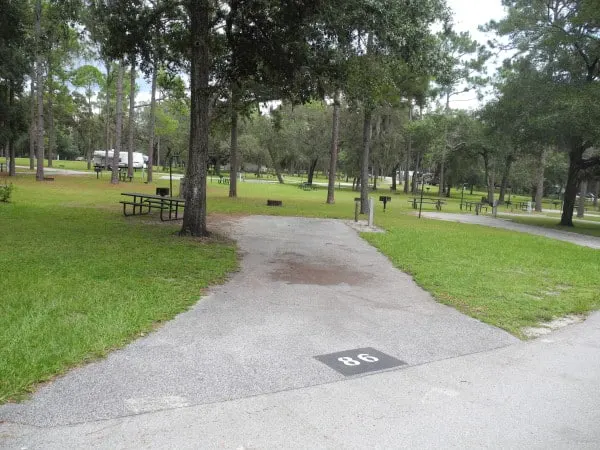
The Salt Springs Campground has 106 sites with full hookups for either RV’s or tents and another 54 sites without hookups for tents only. In addition to water, sewer and electric hookups on RV sites, all sites have a picnic table, fire ring, grill and lantern post.
Facilities also include rest rooms with showers and an RV dump station. Firewood is available.
The recreation area is near a gas station, grocery store, restaurant, bait and tackle shop, post office and laundromat in the adjacent community of Salt Springs.
RV sites with hookups are usually booked solid, even after the tourist season, so reservations are a must. I’ve had little luck booking a site here, although campers with more patience and date flexibility should do better.
Salt Spring gets its name from its mineral content — potassium, magnesium, and sodium salts — giving the water a slight salinity.
Salt Springs Recreation Area, 13851 FL-19, Fort McCoy, FL 32134. Phone: (352) 685-2048. Camping Fee: $65/night with full hookups; $34 for seniors and Access Pass holders; $31/night for tents, no hookups. (2023-24 rates) Change or cancellation fees: $10. Pets: OK in campground. Reservations: Book online at Recreation.gov up to 6 months in advance or call 1-877-444-6777. Maximum stay 14 nights. This campground does have a few sites set aside for first-come, first-served. For last-minute availability, call the campground directly at (352) 685-2048. Open all year.
Directions to Salt Springs: Salt Springs is located between the St. Johns and Ocklawaha Rivers, 35 miles east of Ocala, Florida on State Road 19, north of State Road 40, which crosses the state from Ormond Beach to Ocala.
Note: Florida state fishing and boating license requirements apply in Ocala National Forest.
Alexander Springs Recreation Area
One of only 27 first-magnitude springs in Florida, Alexander Springs is one of the best freshwater swimming hole in the state of Florida, not to mention one of the busiest.
The spring head creates a large, shallow sandy-bottom natural pool at a constant 72 degrees. Where the spring emerges from the bottom, snorkelers and scuba divers explore the limestone rocks and boulders in the spring boil.
Visitors enjoy canoe and kayaking (rentals available), hiking, off-road bicycle trails and picnic area. Trailhead for the Paisley Woods Bicycle Trail, a 22-mile loop through the forest begins here.
The launch area for the spring run was a bit of a hike from the nearest parking, so I’d recommend a kayak cart to carry the load on the asphalt path.
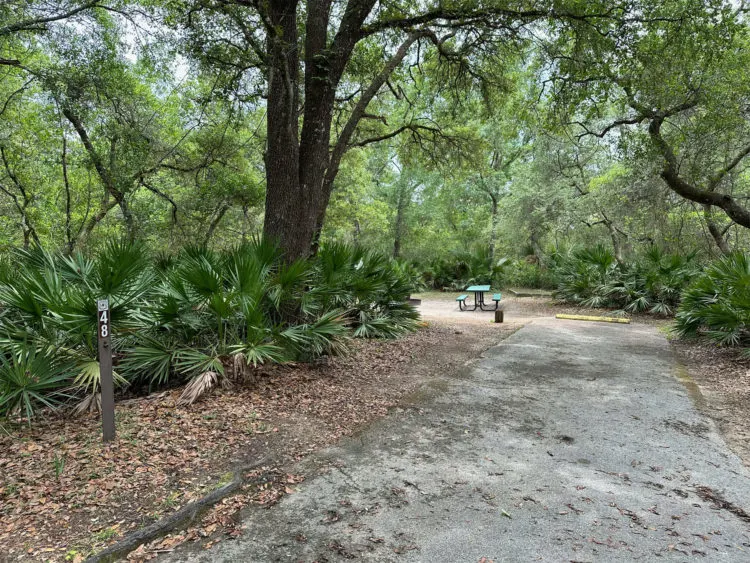
The campground has 67 sites for tents or RVs up to 35 feet, but there are no hookups. Every site has a picnic table, fire ring and grill. All campsites had decent shade.
We saw about a half-dozen pull-through sites alongside the main campground road.
Potable water spigots are shared, there are two bath houses with hot showers a short walk from all sites and a single dump station is positioned near the campground exit.
The campground seems well-maintained, although it’s showing its age.
You can walk to the day-use recreation area and springs.
Alexander Springs Recreation Area, 49525 County Rd 445, Altoona, FL 32702. Phone: (352) 669-3522. Camping Fee: $34 per night (2022) Pets: OK in the campground. Reservations: Book online at Reservations.gov up to 6 months in advance, or call 877-444-6777.
Read more: Alexander Springs: Easy scenic paddling; lots of wildlife
Directions to Alexander Springs: From SR 40 at Astor, take Butler Street to CR 445A, and turn left on CR 445. The recreation area is 5.8 miles south on the right.
Juniper Springs Recreation Area
Juniper Springs is exceptionally beautiful with dense tropical foliage, and it’s the most well-known destination in Ocala National Forest.
Visitors kayak or canoe the spring run, swim at the spring head, off-road bicycle trails and hiking. There are canoe and kayaks available to rent, but you can bring your own boat for a $10 launch fee.
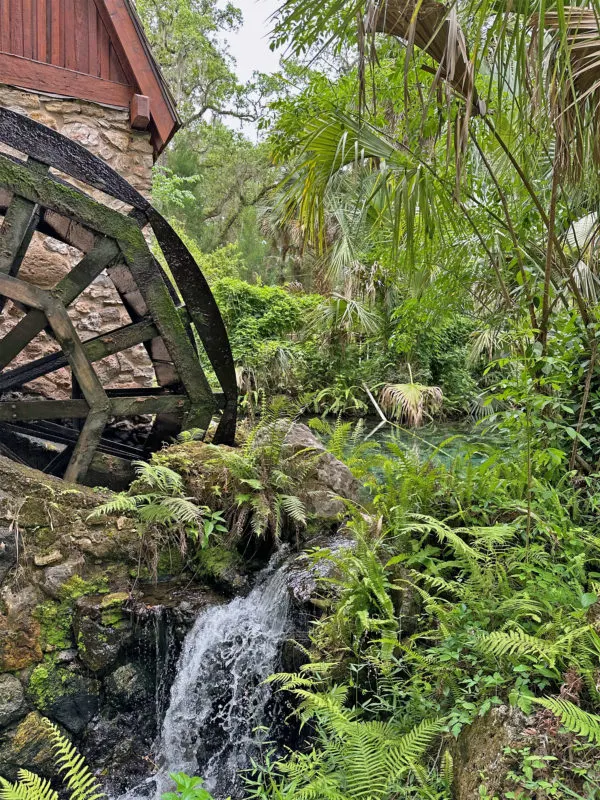
Unfortunately, the concession no longer operates a shuttle to the popular take-out on U.S. 19, so you’ll either have to paddle down and back to the launch or arrange your own shuttle for this spectacular 7.3-mile spring run.
The gated campground has been named one of the Top 100 Family Campgrounds in the United States, and reservations are competitive for its 79 campsites, 19 of which are set aside for tents only.
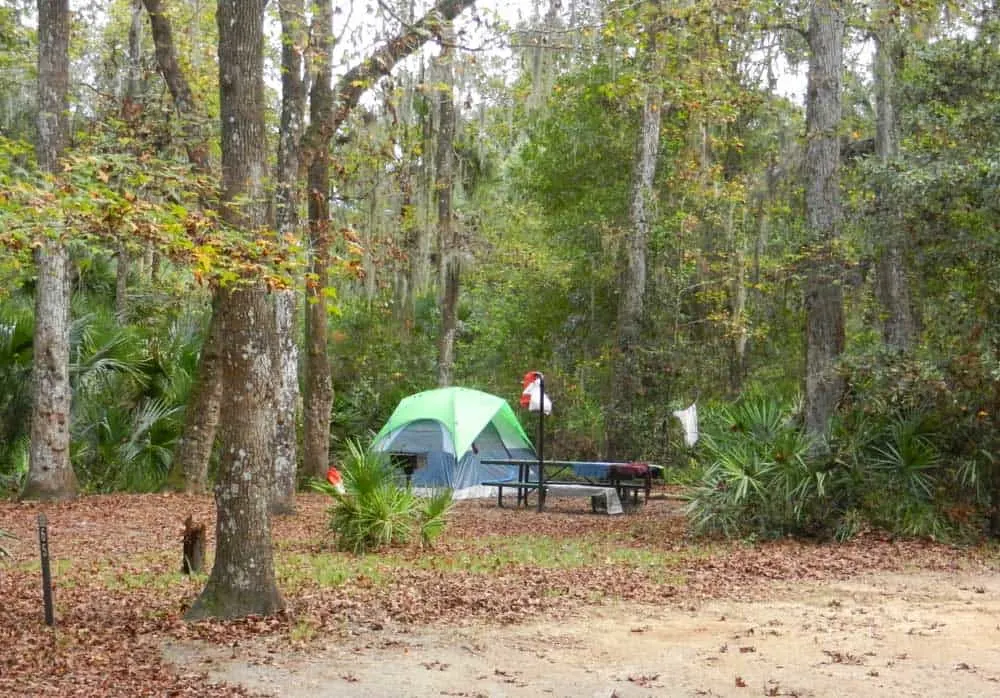
Like other campgrounds in Ocala National Forest (except Salt Springs), there are no hookups. Each site has a picnic table, fire ring, grill and lantern post. Campers share water spigots, rest rooms with showers, and there’s a dump station in the campground.
The concession at the spring head sells snacks, groceries, charcoal, firewood, ice and novelties. A convenience store with camping supplies, beach supplies, drinks and ice cream is nearby. Restaurants, shopping and gas are 10 miles from campground.
Reservations are recommended, especially during the winter tourist season.
Juniper Springs Recreation Area, 26701 FL-40, Silver Springs, FL 34488. Camping Fee: All sites are $34 per night, tent or RV. (2023 rates). Pets: OK only in campground. Reservations: Book online at Recreation.gov or call 1-877-444-6777 up to 6 months in advance. Maximum stay 14 nights.
Read more: Fab kayaking on pristine Juniper Spring Run
Directions to Juniper Springs: From I-75, take Highway 40 east through Ocala and Silver Springs for approximately 36 miles to the Juniper Springs Recreation Area. From I-95, take the Ocala/Silver Springs Exit (Highway 40) west for approximately 37 miles to the Juniper Springs Recreation Area. From the intersection of Highway 40 and Highway 19, the campground is 4.5 miles west on Highway 40. The entrance is on the north side of Highway 40.
Clearwater Lake Recreation Area Campground
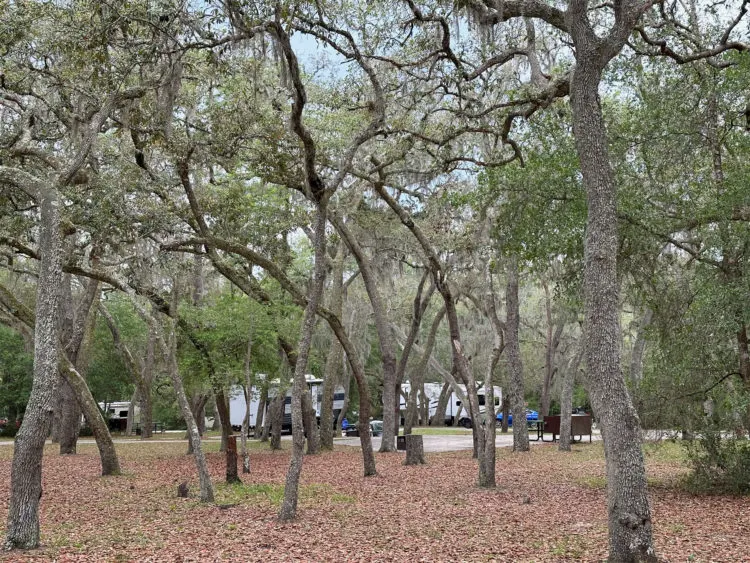
When we arrived at Clearwater Lake Recreation Area, we felt like we were in a lonely little corner of Ocala National Forest, and that’s not a bad thing. We found it peaceful in its isolation, near the tiny hamlet of Paisley on the forest’s southern border.
A big attraction, aside from shady and spacious campsites, is the nearby Paisley Woods Bicycle Trail, a 22-mile single-loop trail through pristine forest to the Alexander Springs Recreation Area.
While classified as a recreation area, the “beach” is not much to look at, nor is the shallow lake anything to get excited about, and levels depend on forest runoff.
But if you’re looking to spend a lazy afternoon in a canoe or kayak, available for rent at the ranger station, this might be a good destination for locals.
There is a 1.2-mile hiking trail that circumnavigates the lake, and the Florida Scenic Trail passes near here after winding 72 miles through the forest.
The campsites are spacious and shaded in an oak hammock with many facing the lake where they can catch a breeze.
The recreation area is gated and has 42 sites for tents or recreational vehicles, but no hookups. Each site has a picnic table, fire ring and grill. Potable water and a dump station are available, as are restrooms with showers and firewood.
Loop A is closer to the beach and has more lakefront sites (I especially liked 10, 13 and 15), while Loop B sites 24-42 enjoy relief is a picturesque hammock of live oak.
Our little secret: There is a path to the lake between Loop B sites 34 and 36, making them ideal for kayakers.
This campground has first-come, first-served sites, but you should have a backup plan during the peak winter season.
We found the couple managing Clearwater Lake to be very pleasant and personable.
Clearwater Lake Campground, 24511 Co Rd 42, Paisley, FL 32767. Phone: (352) 669-0078 Campground Fee: $34/night plus tax (2023 rates). No hookups. Pets: Only in campground. Reservations: Book online at Reservations.gov or by calling 1-877-444-6777 up to 6 months in advance. Maximum stay 14 nights. This campground has first-come, first-served sites.
Directions to Clearwater Lake: From the junction of SR 42 and SR 19 in Altoona, drive 6.4 miles east on SR 42 towards Paisley. The entrance to the Clearwater Lake Recreation Area is on your left.
For a story about dispersed camping in the Ocala National Forest backcountry, read Great Escape: Dispersed camping in Ocala National Forest
2 State Parks at the Forest Edge
Two campgrounds with all the amenities (and then some)
Two Florida State Parks with developed campgrounds are on the edges of Ocala National Park — Silver Springs on the west side, near Ocala, and the Rodman Campground on the north side.
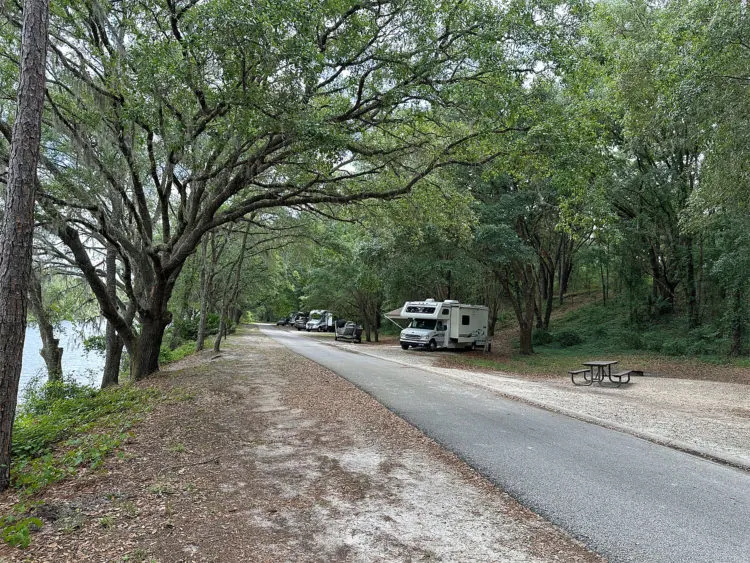
Things to do: Bicycling, fishing, birding, boating, hiking, mountain biking, wildlife. Sites: 64 sites, including 38 with electric and water hookups; 26 primitive tent sites. Camping Fee: $22 with hookups, plus a $7 daily utility fee and a non-refundable $6.70 booking fee; tents, no hookups, $12/night, plus taxes and a non-refundable $6.70 booking fee. Facilities: Picnic tables, fire ring, and lantern posts. A dump station, picnic pavilions, and boat ramps are in the campground. Pets: OK in campground. Reservations: Book online up to 11 months in advance.
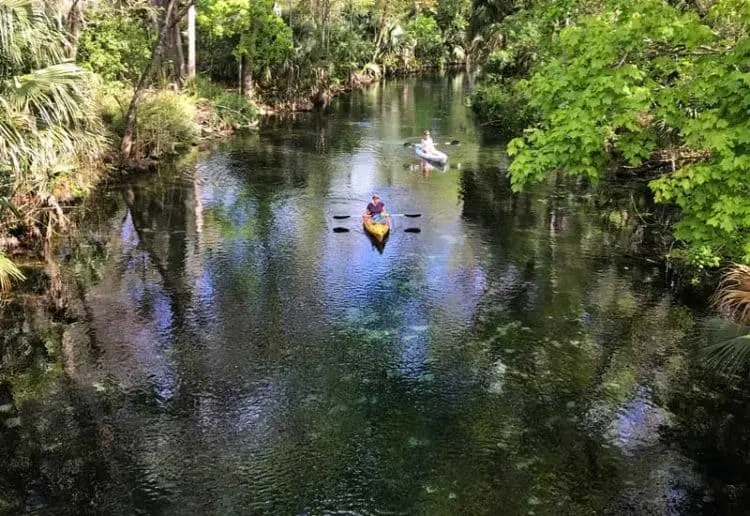
Things to do: Bicycling, mountain biking, glass-bottom boat tours, boating, geo-seeking, hiking, horseback riding, kayaking (rentals available), birds, and wildlife. Sites: 59 RV or tent sites with 50-amp electric and water hookups. Sites 20 & 53 are fully accessible with paved pads and sidewalks leading to both of the campground bathhouses. Camping Fee: $24/night plus $7 daily utility fee and a non-refundable $6.70 booking fee; Cabins: $110, $7 daily utility fee, and a non-refundable $6.70 reservation fee. Facilities: All sites have a fire ring, barbecue grill, and picnic table. Firewood is available for purchase. Pets: OK in the campground. Reservations: Book online up to 11 months in advance.
Read More: Silver Springs State Park: Famous spring plus cabins, hiking, history
Directions to Silver Springs State Park: From the city of Ocala, take State Road 40 east 7 miles to the park entrance.
Camping with Bears, Raccoons and Alligators
Do not feed wild animals — for their health and your safety. Secure food and garbage, using the bear-proof boxes when available.
When people feed wild animals, the animals lose their fear of humans. Next thing you know, they’ll want you for lunch.
Be careful out there!
9 Remote Campgrounds in Ocala National Forest
Rustic and wild, few amenities but lots of adventure
These remote campgrounds in Ocala National Forest are gateways to adventure but have few amenities. Just the basics. A place to pitch a tent or park an RV with a picnic table and fire ring. Maybe.
Many are remote, accessible only from unpaved forest roads and often out of range for mobile phone cellular service. Security may be a consideration.
Some are base camps for all-terrain vehicles, hunters or equestrians, but they are open to all who seek a walk on the wild side of Ocala National Forest.
A few of these campgrounds are real gems. Read on.
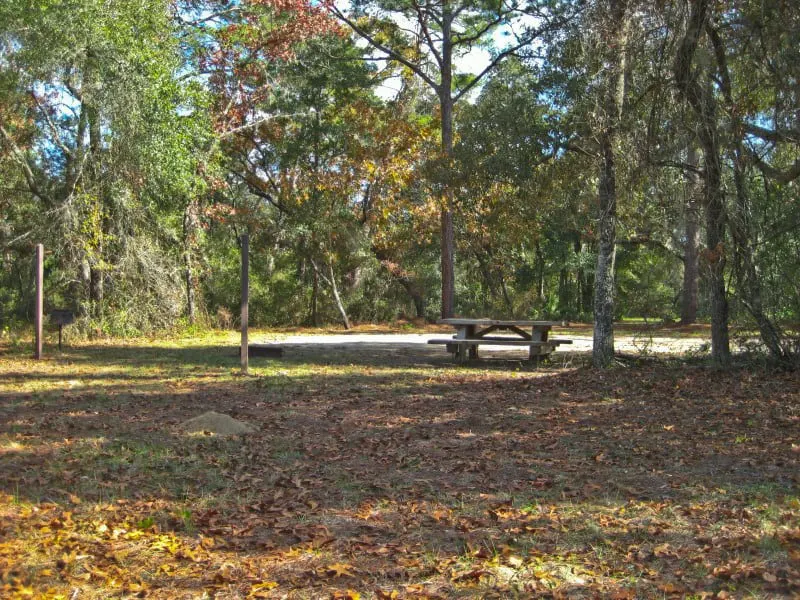
Things to do: Hiking, wildlife, equestrian. Four miles from the Ocklawaha River via CR 42. Sites: 18 sites, no hookups. RVs welcome. There are two new paved accessible campsites close to the restrooms. Camping Fee: $15/night. Usage: Light to medium. Facilities: Grills and fire pits. Dump station. Potable water available. Pets: OK in campground. Reservations: None. First come, first served. Self check-in.
Directions to Big Bass Campground: 8.7 miles east of Weirsdale along CR 42; turn off CR 42 onto Forest Road 13. Watch for the sign on the left after you pass “Buck & Doe’s” store.
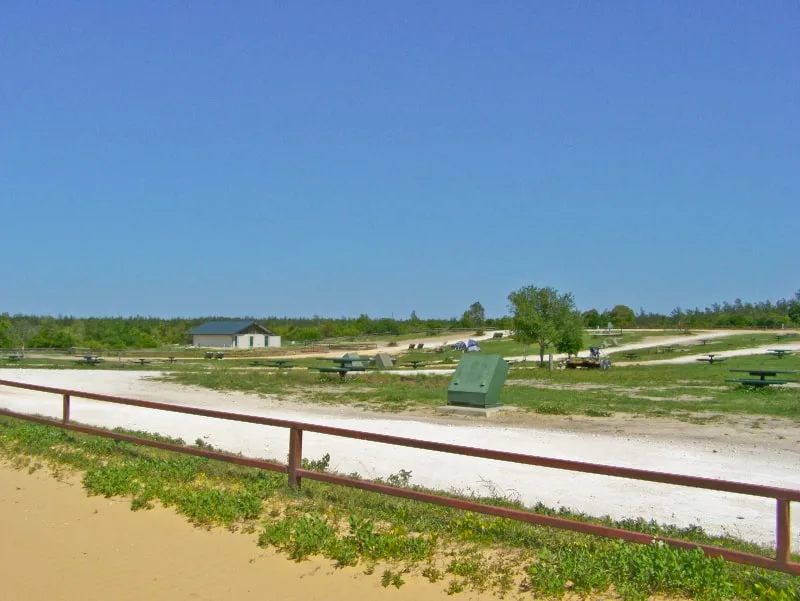
Things to do: Off-road vehicle trails. Sites: 47 sites for tents or RVs. No hookups. Camping Fee: $20/night. Usage: Medium to Heavy. Facilities: Picnic tables, restrooms. Potable water available. No dump station. Pets: OK in the campground. Reservations: Online up to 6 months in advance at Recreation.gov, or by calling 1-877-444-6777, up to six months in advance. A handful of sites are first-come, first-served.
Things to do: Fishing, kayaking. Sites: 3 tent sites. Camping Fee: Free. Usage: Light to medium. Facilities: Boat ramp. Pets: OK in the campground. Reservations: First come, first served.
Directions to Bluff Landing: From Alexander Springs Recreation Area, drive north on County Road 445 towards Astor. Turn right onto Forest Road 18, an unimproved road, after you cross over Alexander Creek. Follow the road for nearly 2 miles to a turnoff on the right as FR 18 makes a sharp right off the main road. Continue another 2 miles or so down to the landing. FR 18 marks the western boundary of the Alexander Springs Wilderness.
Hunting Season
Many of the forest’s remote campgrounds are crowded with hunters during General Gun Season, which usually runs from late October into January. Some may even be closed to non-hunters. For dates, check with the Florida Fish and Wildlife Commission.
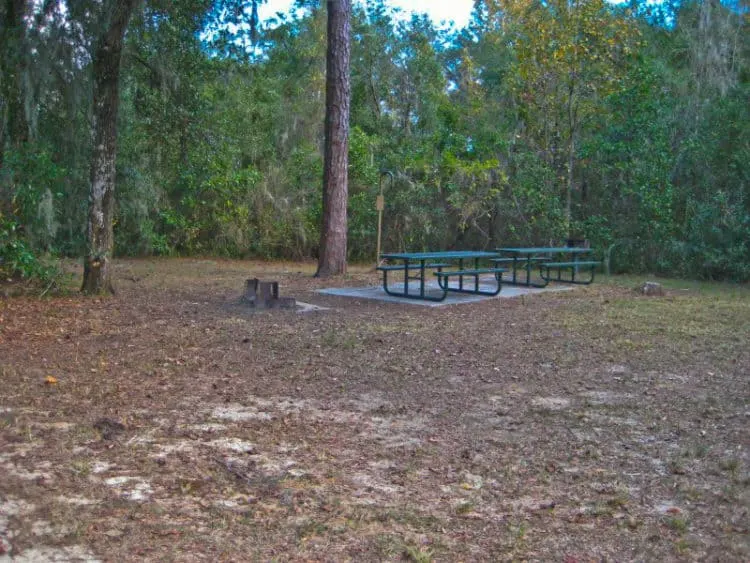
Things to do: Fishing. Sites: 31 sites for tent or RV. Camping Fee: $20/night, no hookups. Usage: Heavy. Facilities: Picnic table, fire ring, bathhouse with flush toilets and warm showers. Drinking water available. Dump station available. Boat ramp. A small grocery store is nearby on SR 314 in Scrambletown. Pets: OK in the campground.
Directions to Fore Lake: Drive 5.1 miles north on SR 314 from Nuby’s Corner (junction of SR 40 and SR 314). Turn left at the Fore Lake sign and continue 0.7 miles to the recreation area.
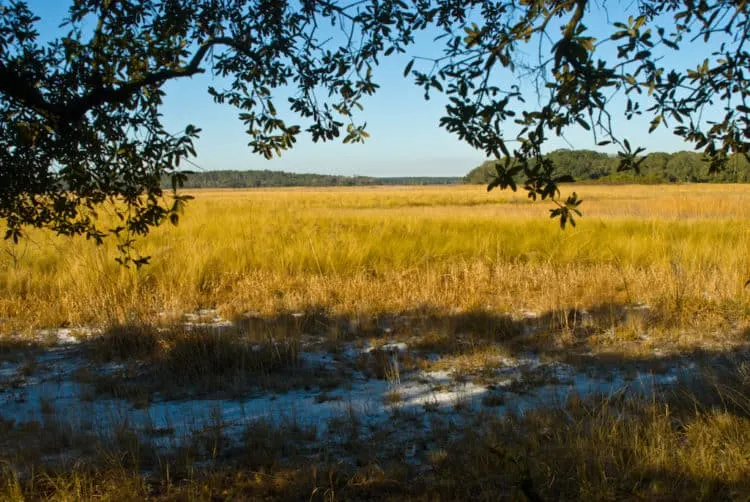
Things to do: Fishing, hiking the Florida Scenic Trail, birding. Sites: 21 Camping Fee: $12/ night. (2023) Usage: Heavy. Facilities: Hand pump for drinking water. Vault toilets. Boat ramp (fee $5) Nearby Salt Springs has groceries, restaurants, gas station, and outfitter. Pets: OK in campground. Reservations: First come, first served. No reservations but you can use recreation.gov to pay with credit card instead of cash.
Directions to Hopkins Prairie: The turnoff for Hopkins Prairie is 9.2 miles north along SR 19 from the intersection with SR 40. Turn left and follow the signs, turning left, right, and left along unmarked, unimproved roads to reach the camping area.
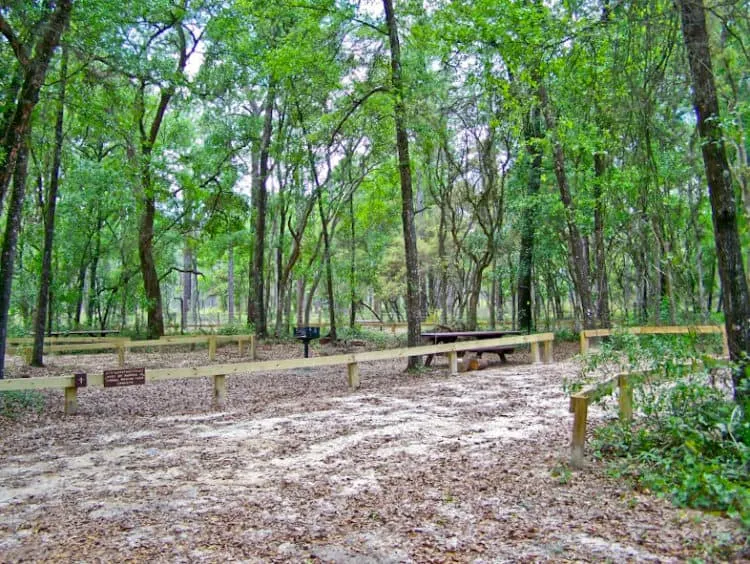
Things to do: OHV trails from the West campground. Fishing and kayaking in the East campground. Sites: East, 29 primitive sites for tents and trailers; West, unmarked primitive sites. Camping Fee: East, $15/night. West, $5/night. Usage: Heavy. Facilities: Boat ramp. Shaded picnic grounds and drinking water available in west. Pets: OK in the campground. Reservations: None. First come, first served.
Directions to Lake Delancey: From Salt Springs, drive north along SR 19 for 5.7 miles to the “Lake Delancy” sign on the left side of the highway. Follow Forest Road 66 to the appropriate campground.
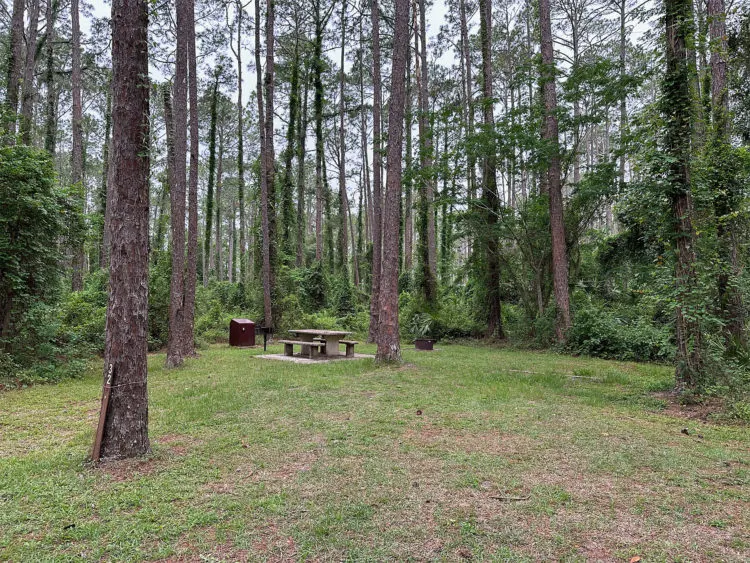
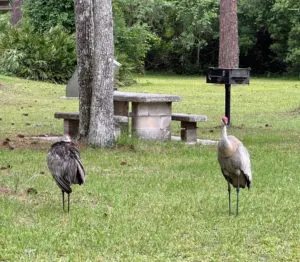
Things to do: Fishing, picnicking and hiking. Sites: 34 sites for tent or RV. No hookups. Camping Fee: $20 per night for camping.; $5 boat launch fee. The cabin is $142.87 per night plus tax, minimum 3-night stay. Usage: Heavy. Facilities: Picnic table, fire ring and a grill. Drinking water spigots (shared) and a bathhouse. Boat ramp. No dump station. Pets: OK in campground. Reservations: Up to six months in advance on recreation.gov
Directions to Lake Dorr: Drive north along SR 19 from Altoona and watch for the sign on the right, across from the Pittman Visitor Center.
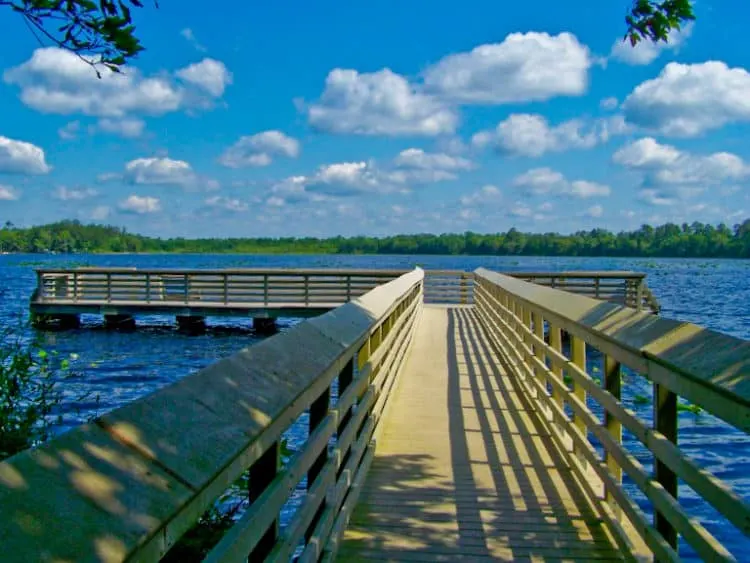
Things to do: Fishing. Sites: 13 tent or RV. No hookups. Camping Fee: $10/night for a single site; $15 for a double site. $5 fee for day-use pass, includes the boat ramp. Facilities: Picnic tables, fire ring, lantern post, boat ramp, fishing pier, vault toilets, no water. Groceries, hardware and gas six miles away. Pets: OK in campground.
Directions to Lake Eaton: South on CR 314-A from CR 314 for 2.5 miles. Turn left on Forest Road 44, an unimproved and deeply rutted road, and make a sharp left at the “Lake Eaton Campground” sign. At the corner of NE 171 Ave Rd and NE 61st Street Rd, continue straight through the recreation area gates. The campground gates are on the right.
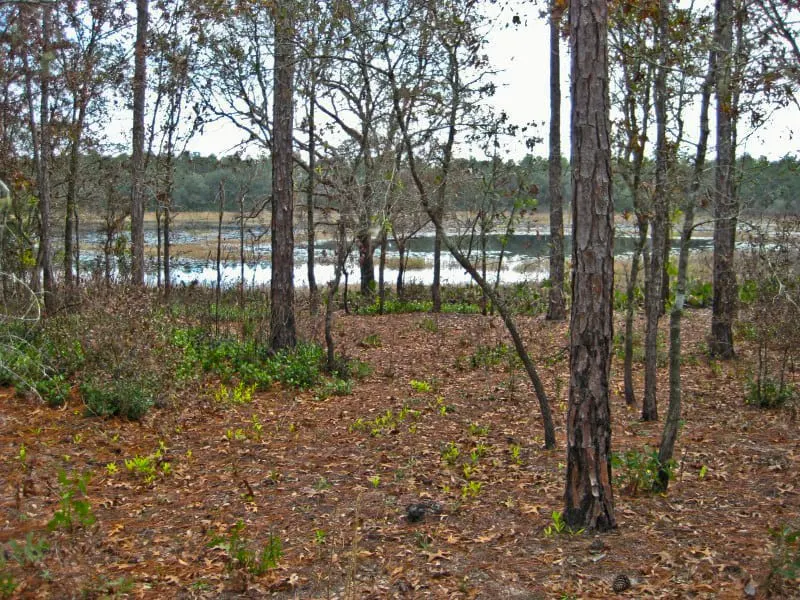
Things to do: Horseback riding. Camping Fee: $10/night. Usage: Heavy. Facilities: Picnic tables, drinking water and toilets. Pets: OK in campground.
Read more: 6 things to do in Ocala National Park
Forest Closures
Closures can occur at any time for a variety of reasons, including fire hazards, bear intrusion, flooding, storms, etc. Other factors, such as military missions and hunting, may also result in closures of specific areas of the forest.
Check before you go:
Visit the Forest Alert Page, which includes the latest notifications for all three National Forests in Florida. You may also check the forest-service Facebook page for updates. You may also call 352-625-2520.
Dispersed Camping
Head out on a trail, camp anywhere
You don’t need a reservation to camp in the back country of Ocala National Forest, you won’t see a fire ring or a picnic table, and you may be camping in a spot where no one has ever camped before.
Know your limits before hiking into the wilderness for an overnight camping adventure. To help you get started, read this story by Florida Rambler contributor Kyle Albinus.
Identify a trailhead where you can park, but it’s probably best to park in a secure area, such as a campground with a host or recreation area where you may be charged a parking fee — much better than returning to an isolated trailhead and finding your vehicle gone.
Dispersed camping is prohibited during General Gun Hunting Season (late October to January), except in designated campgrounds and the Juniper Prairie Wilderness.
Other starting points for dispersed camping are in these designated wilderness areas:
- Alexander Springs Wilderness
- Billie Bay Wilderness
- Davenport Landing
- Davenport Landing Trail
- Juniper Prairie Wilderness
- Little Lake George Wilderness
- St. Francis Trailhead
Before embarking on an overnight hike, backpackers should check in at the forests’s Pittman Visitor Center in Altoona for the latest trail conditions and forest notices. It’s also a good idea to leave your backcountry plan with rangers in case you get lost.
While you’re there, spend $12 and pick up an official forest service map, which shows campgrounds, trailheads, campgrounds and more.
Additional Resources
The official Ocala National Forest Visitors Guide, actually a detailed full-color map, is available online for $14 plus shipping. I purchased this map at the Pittman Visitor Center and found it very useful during my visit to the forest.
The Florida Scenic Trail cuts through Ocala National Forest for 72 miles with multiple access points, including (south to north) Clearwater Lake Recreation Area, Alexander Springs, Buck Lake, Farles Lake, Juniper Springs, Hopkins Prairie, Salt Springs Recreation Area, Lake Delancy and Rodman State Park. (See campground listings above).
Few know the trails in Ocala National Forest better than veteran outdoors writer Sandra Friend, who details more than two dozen day hikes and overnight camping on her web site, FloridaHikes! On Sandra’s web site, you can also purchase hiking guidebooks useful in Ocala National Forest and elsewhere in Florida.
Florida Rambler articles about Ocala National Forest
- Great escape: Dispersed, primitive camping in Ocala National Forest
- 6 Things to Do in Ocala National Forest
- Juniper Springs in Ocala Forest: Fab kayaking at pristine spring run
Books of interest on Amazon
Delorme’s Florida Atlas and Gazetteer, $20 at Amazon. A comprehensive guide to Florida’s backcountry with detailed maps, including the extensive network of Ocala National Forest roads (paved and unpaved), trailheads, boat ramps, fishing holes, and more. An ideal companion for exploring Florida’s outdoors.
Haunted Ocala National Forest, $23 on Amazon. Author and folklorist Christopher Balzano takes readers deep into Ocala National Forest and beyond for true stories, urban legends and haunted folklore.
Florida Birds: A folding pocket guide. $8 on Amazon. Includes 140 of the most common and familiar species as well as an ecoregion map showing over 20 bird-finding hotspots.
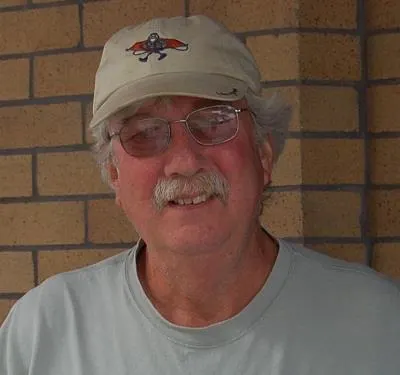
Bob Rountree is a beach bum, angler and camper who has explored Florida for decades. No adventure is complete without a scenic paddle trail or unpaved road to nowhere. Bob co-founded FloridaRambler.com with fellow journalist Bonnie Gross 14 years ago.

Jimmy
Wednesday 21st of June 2023
Hello which campground is the picture below the following: Are the sites really across from the water that close?
2 State Parks at the Forest Edge Two campgrounds with all the amenities (and then some)
Two Florida State Parks with developed campgrounds are on the edges of Ocala National Park — Silver Springs on the west side, near Ocala, and the Rodman Campground on the north side.
Thanks!
Bob Rountree
Wednesday 21st of June 2023
Yes! Ten sites (#59-68) at the Rodman State Park Campground are directly on the Cross Florida Barge Canal, as shown in the photograph. The canal banks are high, though, and the canal is inaccessible.